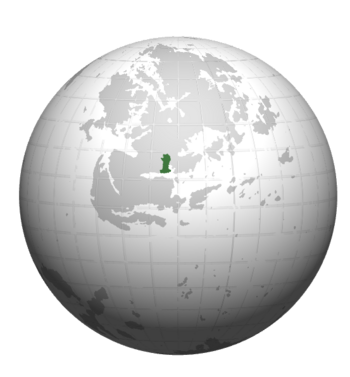Bergenaria
Bergenaria Reino Federal de Bergenaria | |
|---|---|
| 'Motto: 'Equidad en la Justicia Equality in Justice | |
| Anthem: "¡Oíd, mortales!, el grito sagrado!" | |
 | |
| Capital | Serenno |
| Official languages | Stillian de facto |
| Recognized languages | Stillian and 12 Aromatic languages |
| Ethnic groups | Bergenaran, Anirians, and other diverse groups. |
| Religion | 88.9% Christianity
—77.7% Roman Catholic —11.2% Protestantism 8.1% Irreligious 0.2% Others 2.5% Unaffiliated (believer) |
| Demonym(s) | Bergenaro, Bergenario. |
| Government | Federal parliamentary constitutional monarchy |
| Clemente VIII | |
| Sonia Almenares | |
| Legislature | Congreso Nacional |
| Senate | |
| Chamber of Deputies | |
| Unification | |
• Collapse of the Holy Bergenaran Empire | 12 September 1834 |
• Consumation of the Revolución Liberal | 18 September 1834 |
• Start of the Revolución del Cempasuchil | 2 November 1867 |
• Proclamation of the Kingdom | 1 January 1873 |
• Two Thousand Days War | 21 November 1948 |
• Current constitution | 29 December 1971 |
| Area | |
• Total | 238,900 km2 (92,200 sq mi) |
| Population | |
• 2020 census | 29,000,000 |
• Density | 121.3/km2 (314.2/sq mi) |
| GDP (PPP) | 2020 estimate |
• Total | $439,350 million |
| GDP (nominal) | 2020 estimate |
• Per capita | $15,150 |
| Gini (2016) | 33.0 medium |
| HDI (2019) | 0.904 very high |
| Currency | Bergenarian real (BGR) ([[Wikipedia:ISO 4217|ISO 4217]]) |
| Time zone | UTC+6 UTC +7 |
| Date format | dd-mm-yyyy |
| Driving side | right |
| Calling code | +34 |
| Internet TLD | .ber |
Bergenaria, officially known as the Federal Kingdom of Bergenaria (Stillian: Reino Federal de Bergenaria) is a country located in the central Amutian part of Europa on Eurth. It is bordered to the east by Red Iberos, to the north by Qubdi and to the south by Haken Bay and Norrium. Bergenaria covers 238,900 square kilometers (92,239 sq mi) and is home to approximately 29 million people. The capital and largest city of Bergenaria is Serenno; other major urban areas include Santiago de Ángeles, Caronia, Izquina, Arianza, San Cristóbal de Grenica, Zamora, Santa Catarina de Compostela, and Aniria, all around eighteen autonomous communities.
Anatomically modern humans lived in the temperate caves of the country from around 17,000 B.C. Modern archaeologists and anthropologists maintain that the settlement known as the Arianza Complex (Stillian: Complejo de Arianza) could have been the first city founded when human beings moved to a sedentary lifestyle and agriculture. Different societies were formed around the current Cempasúchil Valley (Stillian: Valle de Cempasúchil) with city-states such as Caronia, Arianza and Zamora having the hegemony of trade in the area. Prior to the Norric conquests, the kingdoms of Bergenaria were disunited. Historians suggest that cultural and religious trade and exchange with northern and eastern Europan nations brought the modern Stillian language and Catholisicsm.
Empires such as the Ascendancy of Aniria and the Grand Duchy of Caronia soon rose to annexation of the small kingdoms and cities in the area. The Salam conquests of Norrium in 545. They forced the Christian kingdoms of the Cempasúchil Valley to form the Alliance of Kingdoms (Stillian: Alianza de Reinos), carrying out the reconquest and defense of the area, concluding around the fourteenth century, with the expulsion of the Salams and the creation of the Treaty of Grenica.
The Treaty of Grenica gave birth to eighteen kingdoms in the Cempasúchil Valley, divided among the heirs of the last leader of the Alliance of Kingdoms, Aureliano el Cid Campeador. From this, the so-called Holy Bergenarian Empire emerged, which would persist until the 19th century, when liberal revolutionaries executed Emperor Ludovico II. The liberal revolution led to the proclamation of a federation that would last until the so-called Cempasúchil Revolution, leading to the restoration of the monarchy and the unification of the kingdoms of the Cempasúchil Valley in the so-called Kingdom of Bergenaria. The early 20th century would engulf the country in a brief economic and technological renaissance, defying the predictions of former monarchists. The so-called Florecimiento stalled in the late 1910s and culminated in an economic crisis in 1926. Federalist sentiments and political instability that began after the economic crisis erupted into violence in the so-called Two Thousand Days War (Stillian: Guerra de los dos mil días) in 1948.
After the civil war and the victory of the monarchists, the country would reinvent itself for the second time. The once strictly monarchical kingdom passed into the 1961 Reformation, opening monarchical rule to liberal and progressive ideals once considered abhorrent due to its close connection to the long-defunct Centralist Republic. In 1993, the country would go through its transition to democracy, maintaining, however, some monarchical powers such as the individual power of the Dukes and the Royal Family. Today, the Federal Kingdom of Bergenaria has a healthy respect for human rights, a semi-stagnant economy, and a society that has combined monarchical traditions with modernity.
Etymology
There are several hypotheses about the origin of the word Bergenaria. The first version suggests that it comes from a mispronunciation by Catholic generals of the Berengaria River that crossed the current capital of Serenno during the Reconquista. The second, and the most accepted, suggests that Bergenaria comes from Queen Bergenaria of Caronia, wife of King Damaso de Aniria which united briefly the kingdoms into an alliance. Legend says that during the height of the Reconquista, Bergenaria rode on a horse with a spear and a shield during the Siege of Arianza and when victorious, she took hands with her husband, creating the image of the coat of arms.

